Comparison of Supplemental LED Top- and Interlighting for Year-Round Production of Cherry Tomato
Abstract
:1. Introduction
2. Materials and Methods
2.1. Plant Material and Growth Condition
2.2. LED Supplemental Lighting
2.3. Measurements
2.3.1. Plant Growth, Yield and Fruit Quality
2.3.2. Light-Use Efficiency and Energy-Use Efficiency
2.4. Data Analysis
3. Results
4. Discussion
4.1. Effect of Different Supplemental Lighting Position on Yield
4.2. Light- and Energy-Use Efficiency at Different Supplemental Lighting Positions
4.3. Effect of Different Supplemental Lighting Position on Quality
5. Conclusions
Author Contributions
Funding
Institutional Review Board Statement
Informed Consent Statement
Data Availability Statement
Conflicts of Interest
References
- Marcelis, L.F.M.; Broekhuijsen, A.G.M.; Meinen, E.; Nijs, E.M.F.M.; Raaphorst, M.G.M. Quantification of the growth response to light quantity of greenhouse grown crops. Acta Hortic. 2006, 711, 97–104. [Google Scholar] [CrossRef]
- Dorais, M. The use of supplemental lighting for vegetable crop production: Light intensity, crop response, nutrition, crop management, cultural practices. In Proceedings of the Canadian Greenhouse Conference, Niagara Falls, ON, USA, 9 October 2003. [Google Scholar]
- Li, T.; Heuvelink, E.; Marcelis, L.F.M. Quantifying the source-sink balance and carbohydrate content in three tomato cultivars. Front. Plant Sci. 2015, 6, 416. [Google Scholar]
- Palmitessa, O.D.; Paciello, P.; Santamaria, P. Supplemental LED increases tomato yield in Mediterranean semi-closed greenhouse. Agronomy 2020, 10, 1353. [Google Scholar] [CrossRef]
- Paucek, I.; Pennisi, G.; Pistillo, A.; Appolloni, E.; Crepaldi, A.; Calegari, B.; Spinelli, F.; Cellini, A.; Gabarrell, X.; Orsini, F.; et al. Supplementary LED Interlighting improves yield and precocity of greenhouse tomatoes in the Mediterranean. Agronomy 2020, 10, 1002. [Google Scholar] [CrossRef]
- Dorais, M.; Gosselin, A.; Trudel, M.J. Annual greenhouse tomato production under a sequential intercropping system using supplemental light. Sci. Hortic. 1991, 45, 225–234. [Google Scholar] [CrossRef]
- Gómez, C.; Mitchell, C.A. Physiological and productivity responses of high-wire tomato as affected by supplemental light source and distribution within the canopy. J. Am. Soc. Hortic. Sci. 2016, 141, 196–208. [Google Scholar] [CrossRef] [Green Version]
- Gomez, C.; Morrow, R.C.; Bourget, C.M.; Massa, G.D.; Mitchell, C.A. Comparison of intracanopy light-emitting diode towers and overhead high-pressure sodium lamps for supplemental lighting of greenhouse-grown tomatoes. HortTechnology 2013, 23, 93–98. [Google Scholar] [CrossRef] [Green Version]
- Verheul, M.J.; Maessen, H.F.R.; Paponov, M.; Panosyan, A.; Kechasov, D.; Naseer, M.; Paponov, I.A. Artificial top-light is more efficient for tomato production than inter-light. Sci. Hortic. 2022, 291, 110537. [Google Scholar] [CrossRef]
- Appolloni, E.; Orsini, F.; Pennisi, G.; Durany, X.G.; Paucek, I.; Gianquinto, G. Supplemental LED lighting effectively enhances the yield and quality of greenhouse truss tomato production: Results of a meta-analysis. Front. Plant Sci. 2021, 12, 596927. [Google Scholar] [CrossRef]
- Kaiser, E.; Ouzounis, T.; Giday, H.; Schipper, R.; Heuvelink, E.; Marcelis, L.F. Adding blue to red supplemental light increases biomass and yield of greenhouse-grown tomatoes, but only to an optimum. Front. Plant Sci. 2019, 9, 2002. [Google Scholar] [CrossRef] [Green Version]
- Lu, N.; Maruo, T.; Johkan, M.; Hohjo, M.; Tsukagoshi, S.; Ito, Y.; Ichimura, T.; Shinohara, Y. Effects of supplemental lighting with light-emitting diodes (LEDs) on tomato yield and quality of single-truss tomato plants grown at high planting density. Environ. Control Biol. 2012, 50, 63–74. [Google Scholar] [CrossRef] [Green Version]
- Trouwborst, G.; Sander, W.H.; Harbinson, J.; Van, I.W. The influence of light intensity and leaf age on the photosynthetic capacity of leaves within a tomato canopy. J. Hortic. Sci. Biotechnol. 2011, 86, 403–407. [Google Scholar] [CrossRef]
- Pettersen, R.I.; Torre, S.; Gislerød, H.R. Effects of leaf aging and light duration on photosynthetic characteristics in a cucumber canopy. Sci. Hortic. 2010, 125, 82–87. [Google Scholar] [CrossRef]
- Tewolde, F.T.; Shiina, K.; Maruo, T.; Takagaki, M.; Kozai, T.; Yamori, W. Supplemental LED inter-lighting compensates for a shortage of light for plant growth and yield under the lack of sunshine. PLoS ONE 2018, 13, e0206592. [Google Scholar] [CrossRef]
- Tewolde, F.T.; Lu, N.; Shiina, K.; Maruo, T.; Takagaki, M.; Kozai, T.; Yamori, W. Nighttime supplemental LED inter-lighting improves growth and yield of single-truss tomatoes by enhancing photosynthesis in both winter and summer. Front. Plant Sci. 2016, 7, 448. [Google Scholar] [CrossRef]
- Lu, N.; Maruo, T.; Johkan, M.; Hohjo, M.; Tsukagoshi, S.; Ito, Y.; Ichimura, T.; Shinohara, Y. Effects of supplemental lighting within the canopy at different developing stages on tomato yield and quality of single-truss tomato plants grown at high density. Environ. Control Biol. 2012, 50, 1–11. [Google Scholar] [CrossRef] [Green Version]
- Moerkens, R.; Vanlommel, W.; Vanderbruggen, R.; Van Delm, T. The added value of LED assimilation light in combination with high pressure sodium lamps in protected tomato crops in Belgium. Acta Hortic. 2016, 1134, 119–124. [Google Scholar] [CrossRef]
- Dueck, T.A.; Janse, J.; Eveleens, B.; Kempkes, F.L.K.; Marcelis, L.F.M. Growth of tomatoes under hybrid LED and HPS lighting. Acta Hortic. 2012, 952, 335–342. [Google Scholar] [CrossRef]
- Palmitessa, O.D.; Prinzenberg, A.E.; Kaiser, E.; Heuvelink, E. LED and HPS supplementary light differentially affect gas exchange in tomato leaves. Plants 2021, 10, 810. [Google Scholar] [CrossRef]
- Ito, H. Proper solvent selection for lycopene extraction in tomatoes and application to a rapid determination. Bull. Natl. Inst. Veg. Tea Sci. 2009, 8, 165–173. [Google Scholar]
- Schwarz, D.; Thompson, A.J.; Kläring, H.-P. Guidelines to use tomato in experiments with a controlled environment. Front. Plant Sci. 2014, 5, 625. [Google Scholar] [CrossRef] [Green Version]
- Gómez, C.; Mitchell, C.A. In search of an optimized supplemental lighting spectrum for greenhouse tomato production with intracanopy lighting. Acta Hortic. 2016, 1134, 57–62. [Google Scholar] [CrossRef]
- Matsuda, R.; Suzuki, K.; Nakano, A.; Higashide, T.; Takaichi, M. Responses of leaf photosynthesis and plant growth to altered source–sink balance in a Japanese and a Dutch tomato cultivar. Sci. Hortic. 2011, 127, 520–527. [Google Scholar] [CrossRef]
- Heuvelink, E.; Buiskool, R.P.M. Influence of sink-source interaction on dry matter production in tomato. Ann. Bot. 1995, 75, 381–389. [Google Scholar] [CrossRef]
- Verheul, M.J.; Maessen, H.; Panosyan, A.; Naseer, M.; Paponov, M.; Paponov, I. Effects of supplemental lighting and temperature on summer production of tomato in Norway. Acta Hortic. 2020, 1296, 707–714. [Google Scholar] [CrossRef]
- Verheul, M.J.; Maessen, H.F.R.; Grimstad, S.O. Optimizing a year-round cultivation system of tomato under artificial light. Acta Hortic. 2012, 956, 389–394. [Google Scholar] [CrossRef]
- Kumar, K.G.S.; Hao, X.; Khosla, S.; Guo, X.; Bennett, N. Comparison of HPS lighting and hybrid lighting with top HPS and intra-canopy LED lighting for high-wire mini-cucumber production. Acta Hortic. 2016, 1134, 111–118. [Google Scholar] [CrossRef]
- Maeda, K.; Ahn, D.-H. Estimation of dry matter production and yield prediction in greenhouse cucumber without destructive measurements. Agriculture 2021, 11, 1186. [Google Scholar] [CrossRef]
- Gislerød, H.R.; Mortensen, L.M.; Torre, S.; Pettersen, H.; Dueck, T.; Sand, A. Light and energy saving in modern greenhouse production. Acta Hortic. 2012, 956, 85–97. [Google Scholar] [CrossRef]
- Philips GreenPower LED Toplighting Linear. Available online: https://www.lighting.philips.com/main/products/horticulture/greenpower-products/led-toplighting (accessed on 1 May 2021).
- Heuvelink, E.; Dorais, M. Crop growth and yield. In Tomatoes; Heuvelink, E., Ed.; CABI Publishing: Wallingford, CO, USA, 2005; Chapter 4; pp. 85–144. [Google Scholar]
- Kim, H.-J.; Yang, T.; Choi, S.; Wang, Y.-J.; Lin, M.-Y.; Liceaga, A.M. Supplemental intracanopy far-red radiation to red LED light improves fruit quality attributes of greenhouse tomatoes. Sci. Hortic. 2020, 261, 108985. [Google Scholar] [CrossRef]
- Kim, H.-J.; Lin, M.-Y.; Mitchell, C.A. Light spectral and thermal properties govern biomass allocation in tomato through morphological and physiological changes. Environ. Exp. Bot. 2019, 157, 228–240. [Google Scholar] [CrossRef]
- Pan, T.; Ding, J.; Qin, G.; Wang, Y.; Xi, L.; Yang, J.; Li, J.; Zhang, J.; Zou, Z. Interaction of supplementary light and CO2 enrichment improves growth, photosynthesis, yield, and quality of tomato in autumn through spring greenhouse production. HortScience 2019, 54, 246–252. [Google Scholar] [CrossRef] [Green Version]
- Slimestad, R.; Verheul, M.J. Seasonal variations in the level of plant constituents in greenhouse production of cherry tomatoes. J. Agric. Food Chem. 2005, 53, 3114–3119. [Google Scholar] [CrossRef]
- Jiang, C.; Johkan, M.; Hohjo, M.; Tsukagoshi, S.; Ebihara, M.; Nakaminami, A.; Maruo, T. Photosynthesis, plant growth, and fruit production of single-truss tomato improves with supplemental lighting provided from underneath or within the inner canopy. Sci. Hortic. 2017, 222, 221–229. [Google Scholar] [CrossRef]
- Dzakovich, M.P.; Gómez, C.; Mitchell, C.A. Tomatoes grown with light-emitting diodes or high-pressure sodium supplemental lights have similar fruit-quality attributes. HortScience 2015, 50, 1498–1502. [Google Scholar] [CrossRef]
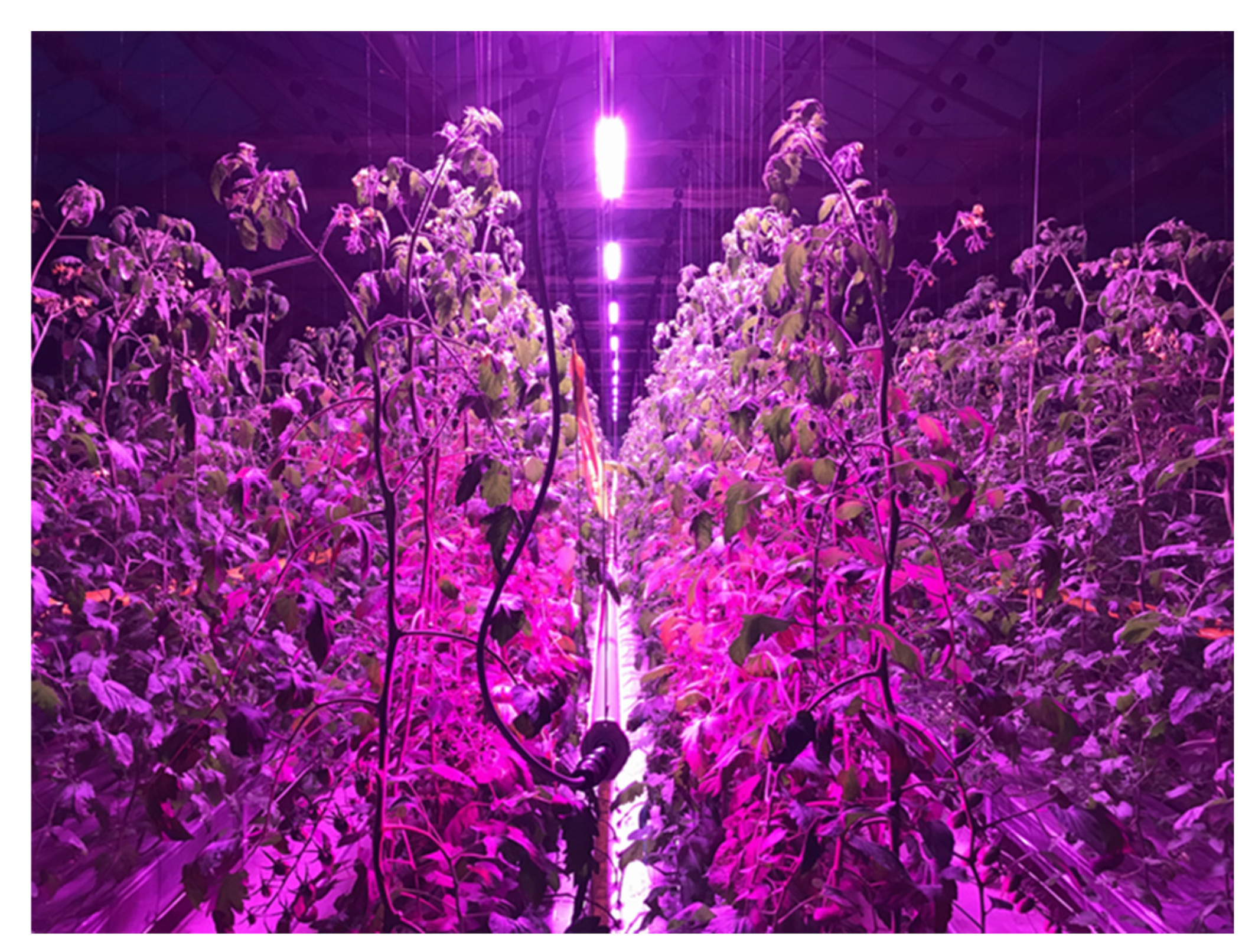
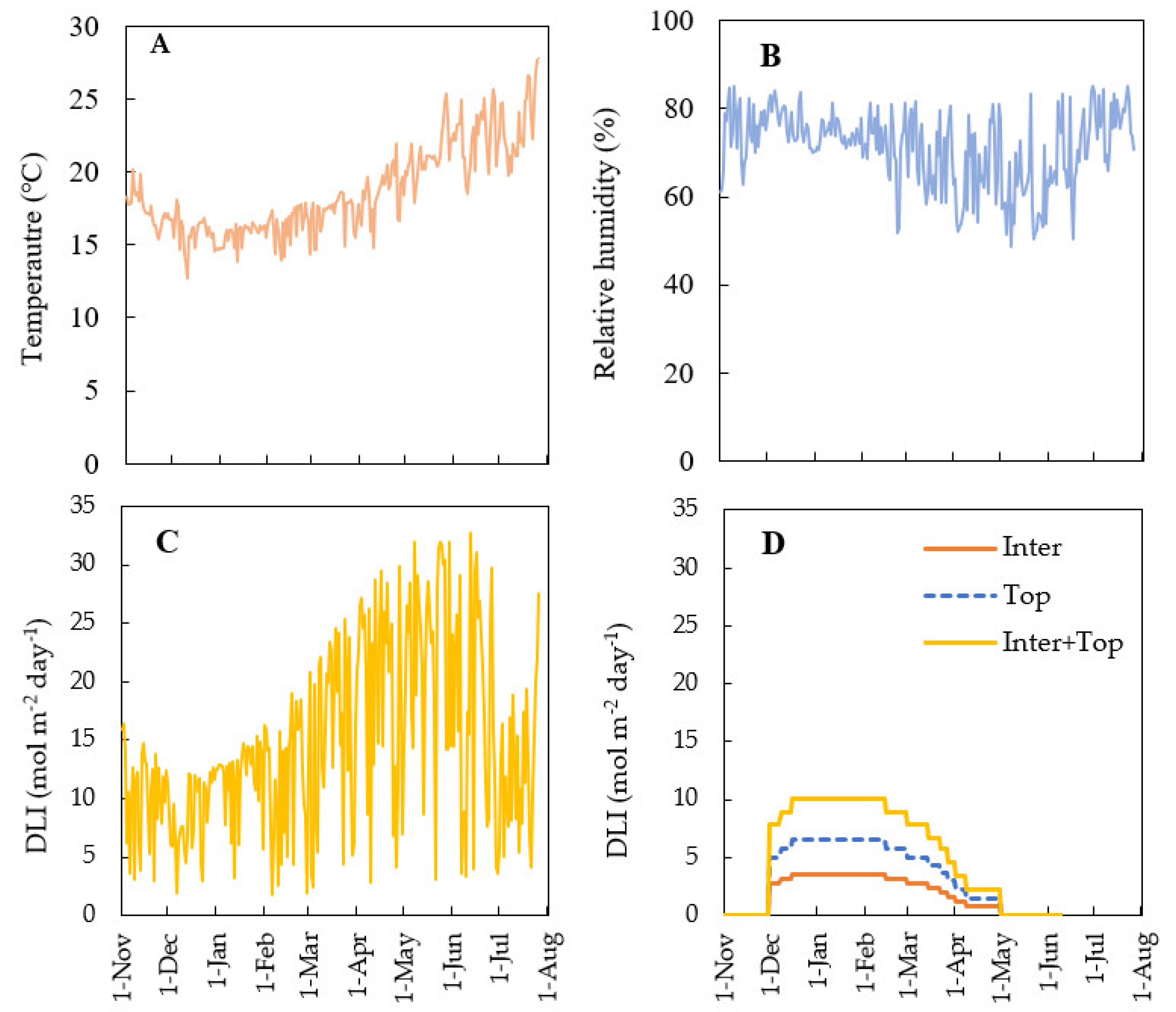
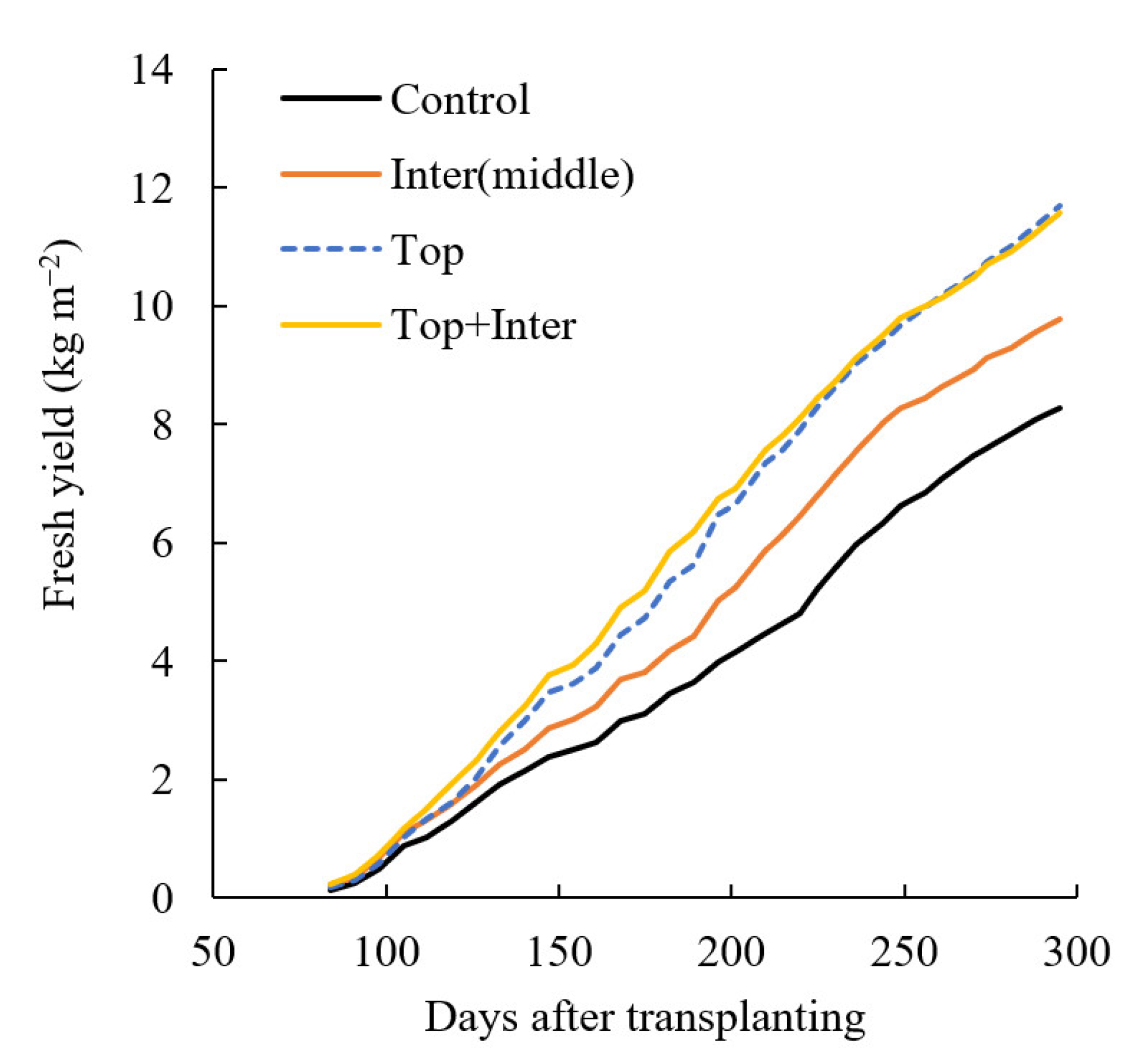
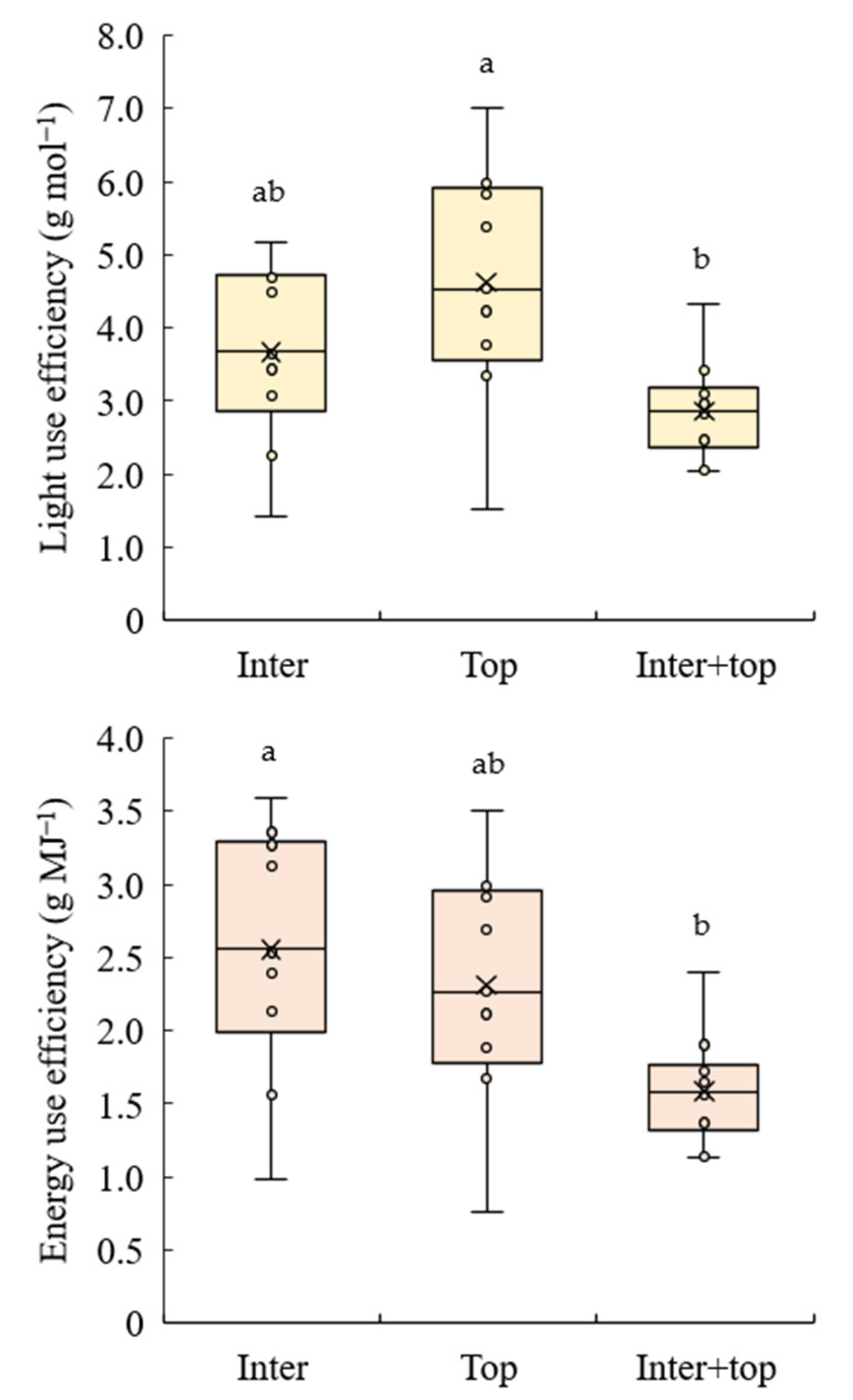
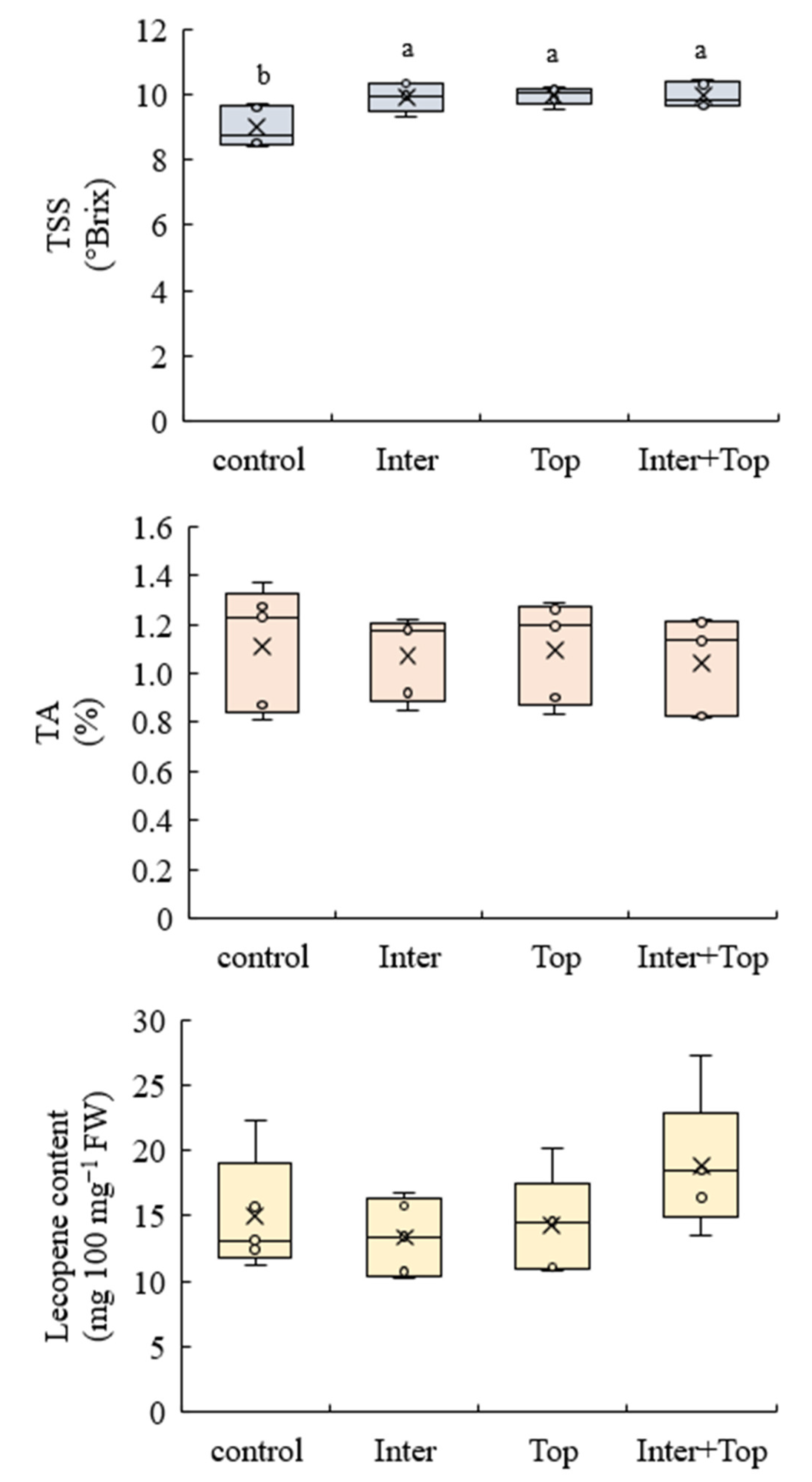
| Treatment | Stem Diameter (mm) | Number of Leaves | LAI (m2/m2) | Yield (kg/Plant) | Number of Fruits | Fruit Weight (g/Fruit) |
|---|---|---|---|---|---|---|
| Control | 7.4 | 26.1 c * | 1.8 | 2.4 c | 233 c | 10.4 b |
| Inter | 7.7 | 28.0 b | 1.7 | 2.8 b | 258 b | 11.0 ab |
| Top | 7.6 | 29.9 a | 1.5 | 3.3 a | 294 ab | 11.4 a |
| Inter × Top | 7.4 | 29.2 ab | 1.8 | 3.3 a | 297 a | 11.4 a |
Publisher’s Note: MDPI stays neutral with regard to jurisdictional claims in published maps and institutional affiliations. |
© 2022 by the authors. Licensee MDPI, Basel, Switzerland. This article is an open access article distributed under the terms and conditions of the Creative Commons Attribution (CC BY) license (https://creativecommons.org/licenses/by/4.0/).
Share and Cite
Maeda, K.; Masuda, E.; Tamashiro, T.; Maharjan, G.; Maruo, T. Comparison of Supplemental LED Top- and Interlighting for Year-Round Production of Cherry Tomato. Agronomy 2022, 12, 1878. https://doi.org/10.3390/agronomy12081878
Maeda K, Masuda E, Tamashiro T, Maharjan G, Maruo T. Comparison of Supplemental LED Top- and Interlighting for Year-Round Production of Cherry Tomato. Agronomy. 2022; 12(8):1878. https://doi.org/10.3390/agronomy12081878
Chicago/Turabian StyleMaeda, Kazuya, Eriko Masuda, Tetsu Tamashiro, Gauri Maharjan, and Toru Maruo. 2022. "Comparison of Supplemental LED Top- and Interlighting for Year-Round Production of Cherry Tomato" Agronomy 12, no. 8: 1878. https://doi.org/10.3390/agronomy12081878
APA StyleMaeda, K., Masuda, E., Tamashiro, T., Maharjan, G., & Maruo, T. (2022). Comparison of Supplemental LED Top- and Interlighting for Year-Round Production of Cherry Tomato. Agronomy, 12(8), 1878. https://doi.org/10.3390/agronomy12081878






